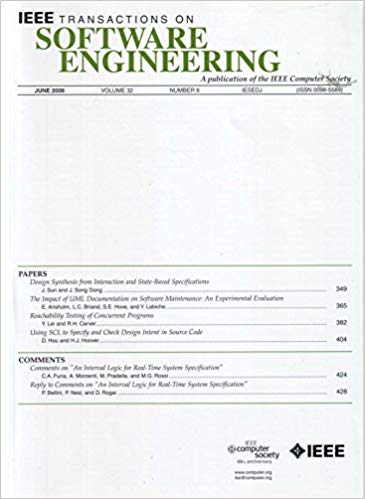描述持续集成中超时构建的特点
IF 6.5
1区 计算机科学
Q1 COMPUTER SCIENCE, SOFTWARE ENGINEERING
引用次数: 0
摘要
支持持续集成(CI,即对开发团队产生的变更集进行自动构建和测试的周期)的计算资源是企业需要管理的共享资源。为防止(错误的)构建消耗大量资源,CI 服务提供商通常会规定一个时间限制。超过时限的 CI 构建会自动终止。虽然设置时间限制有助于防止滥用服务,但超时的构建(a)会消耗 CI 服务愿意提供的最大资源量,(b)会让 CI 用户不知道变更集是通过还是未通过 CI 流程。因此,了解超时的建立和导致超时的因素对于提高 CI 服务的稳定性和质量非常重要。在本文中,我们研究了超时构建的普遍性及其相关特征。通过分析由 936 个采用 CircleCI 服务并报告至少一次超时构建的项目组成的数据集,我们发现超时构建的中位持续时间(19.7 分钟)是产生通过或失败结果的构建时间(3.4 分钟)的五倍多。为了更好地理解导致超时构建的因素,我们根据从 105,663 次 CI 构建中收集到的数据,利用项目构建历史、构建排队时间、超时趋势、规模和作者经验等特征对超时构建进行了建模。我们的模型显示出远远超过随机预测因子的判别能力(接收者操作特征曲线下面积,即 $AUROC$ = 0.939),并且性能高度稳定($AUROC$ 乐观值 = 0.0001)。此外,我们的模型显示,构建历史和超时趋势特征是超时构建的有力指标,其中最近一次构建的超时状态占解释力的最大比例。对超时构建发生率的纵向分析(即在一段时间内进行的研究)表明,64.03% 的超时构建是连续发生的。在这种情况下,中位数为 24 小时后才会出现通过或失败的构建。我们的研究结果表明,CI 提供商应利用构建历史来预测超时构建。本文章由计算机程序翻译,如有差异,请以英文原文为准。
Characterizing Timeout Builds in Continuous Integration
Compute resources that enable Continuous Integration (CI, i.e., the automatic build and test cycle applied to the change sets that development teams produce) are a shared commodity that organizations need to manage. To prevent (erroneous) builds from consuming a large amount of resources, CI service providers often impose a time limit. CI builds that exceed the time limit are automatically terminated. While imposing a time limit helps to prevent abuse of the service, builds that timeout (a) consume the maximum amount of resources that a CI service is willing to provide and (b) leave CI users without an indication of whether the change set will pass or fail the CI process. Therefore, understanding timeout builds and the factors that contribute to them is important for improving the stability and quality of a CI service. In this paper, we investigate the prevalence of timeout builds and the characteristics associated with them. By analyzing a curated dataset of 936 projects that adopt the CircleCI service and report at least one timeout build, we find that the median duration of a timeout build (19.7 minutes) is more than five times that of a build that produces a pass or fail result (3.4 minutes). To better understand the factors contributing to timeout builds, we model timeout builds using characteristics of project build history, build queued time, timeout tendency, size, and author experience based on data collected from 105,663 CI builds. Our model demonstrates a discriminatory power that vastly surpasses that of a random predictor (Area Under the Receiver Operating characteristic Curve, i.e.,
$AUROC$ $AUROC$
求助全文
通过发布文献求助,成功后即可免费获取论文全文。
去求助
来源期刊

IEEE Transactions on Software Engineering
工程技术-工程:电子与电气
CiteScore
9.70
自引率
10.80%
发文量
724
审稿时长
6 months
期刊介绍:
IEEE Transactions on Software Engineering seeks contributions comprising well-defined theoretical results and empirical studies with potential impacts on software construction, analysis, or management. The scope of this Transactions extends from fundamental mechanisms to the development of principles and their application in specific environments. Specific topic areas include:
a) Development and maintenance methods and models: Techniques and principles for specifying, designing, and implementing software systems, encompassing notations and process models.
b) Assessment methods: Software tests, validation, reliability models, test and diagnosis procedures, software redundancy, design for error control, and measurements and evaluation of process and product aspects.
c) Software project management: Productivity factors, cost models, schedule and organizational issues, and standards.
d) Tools and environments: Specific tools, integrated tool environments, associated architectures, databases, and parallel and distributed processing issues.
e) System issues: Hardware-software trade-offs.
f) State-of-the-art surveys: Syntheses and comprehensive reviews of the historical development within specific areas of interest.
 求助内容:
求助内容: 应助结果提醒方式:
应助结果提醒方式:


